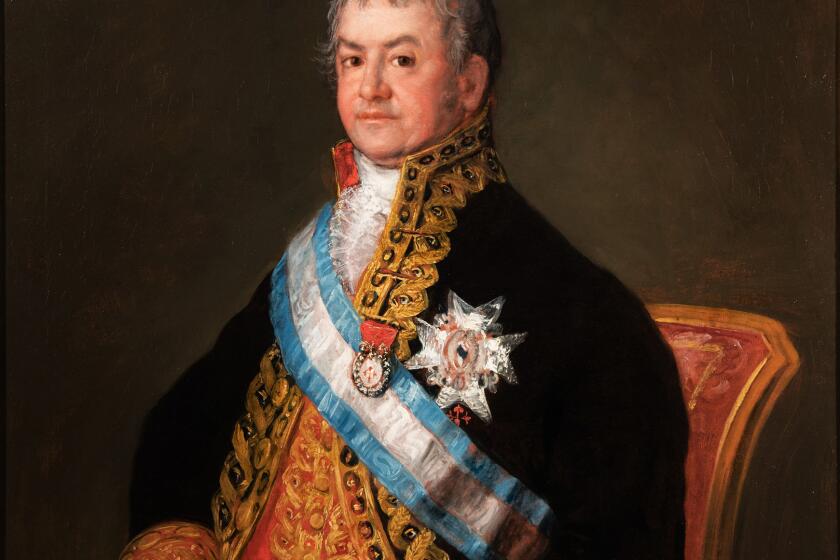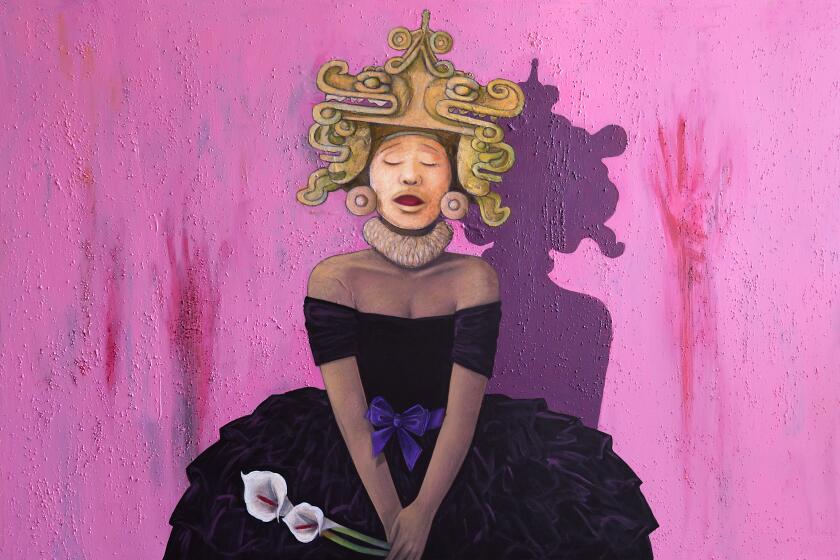Sculptor Sargent Claude Johnson’s core commitment to self-love was a foundation for collective Black pride
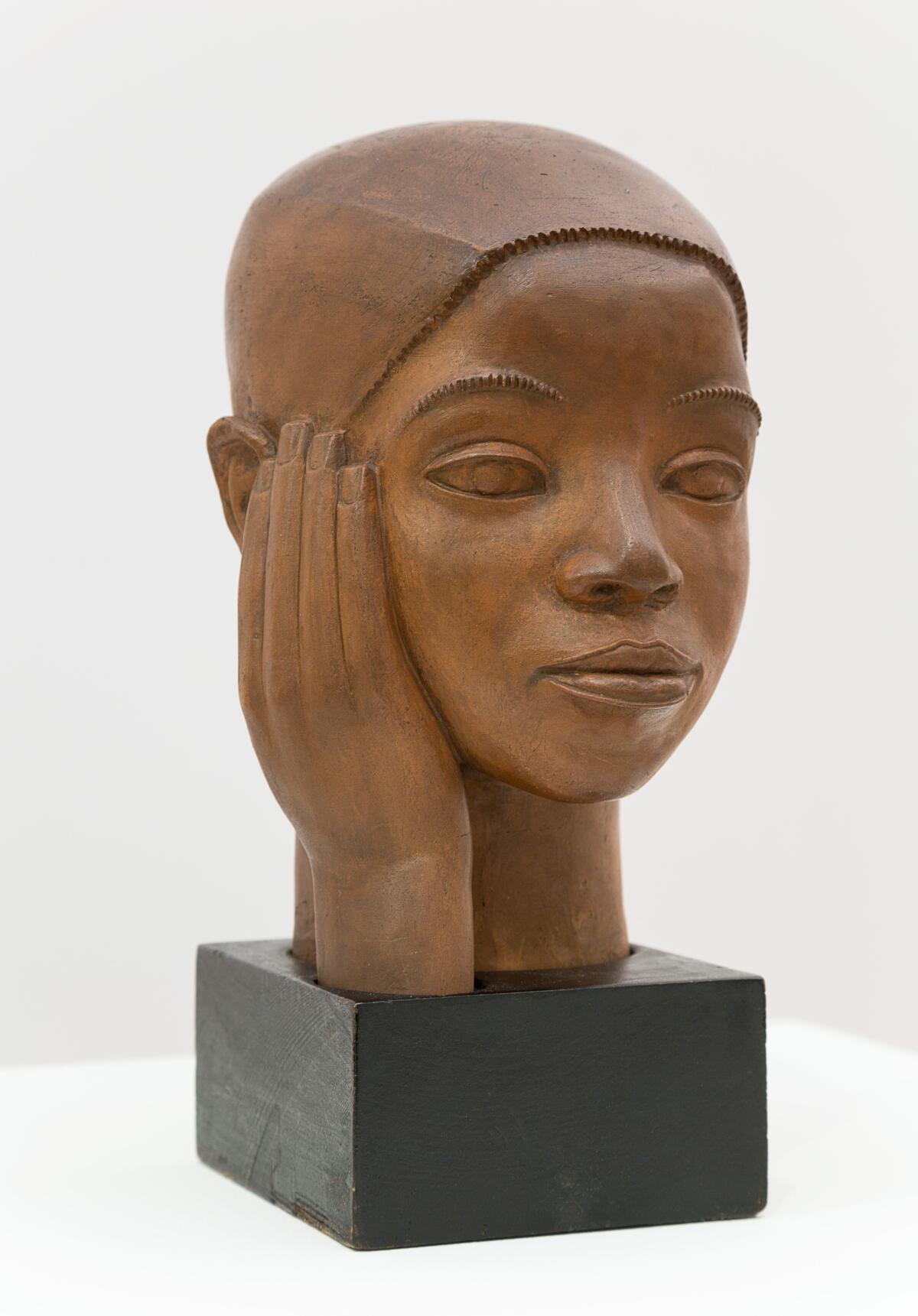
An unusual pose marks figures in three of the 40-plus works by Sargent Claude Johnson in a modest but illuminating survey exhibition of the Bay Area artist, the first since 1998, newly opened at the Huntington Library, Art Museum and Botanical Gardens. The pose speaks volumes.
Two are slightly different versions of a terracotta bust of an unidentified young man, titled only “Chester,” and the third is a chalk drawing of a mother and child. The drawing, one of six works on paper on display, shows a seated woman embracing a child kneeling in front of her, arms wrapped around her ample waist in an enveloping hug.
Whether young man or mom, the gesture puts the palm of his or her right hand up against the head, cupping the cheek. This isn’t a smack-my-head display of shock, horror or dismay — not a one-handed riff on “The Scream.” Unlike Edvard Munch’s epic, open-mouthed, two-handed wail, the faces in Johnson’s art are tranquil and composed, not emotional. His people are poised.
So what is that rather curious pose of hand-to-face about? For one thing, it registers a degree of introspective thoughtfulness — a sort of visual equivalent of “hmm.”

The protective mother and “Chester” are both engaged in reflection. An autobiographical edge is likely, given that Johnson, born in Boston in 1888, was orphaned at 15. Sargent’s father, a white man of Swedish descent, died when the boy was not yet 10. His Black and Indigenous mother succumbed from tuberculosis just a few years later.
Yet I think the gesture is more than introspection — more than an artist at midlife asserting an essential quality of contemplation on his past. Think of the last time you cupped a cheek with the palm of your hand. No doubt it was a gentle, tender gesture of affection — of intimate warmth and care, offered to another. Usually, the gesture is directed outward at a beloved, perhaps even as a prelude to a kiss.
In these works, though, Johnson shifts the recipient. He turns the gesture inward. The boy and the mom are beloved, but it’s their own face that each is shown to caress. Johnson crafted a subtle gesture of self-love — not pompous or vain, but simple and resolute.
Four 2023 gifts, including a Goya portrait and a David Hockney landscape, expand the Huntington’s paintings collection.
That’s what makes these works so compelling. It’s also what makes the work somewhat distinctive in the Harlem Renaissance of the 1920s and ’30s, which began with literary and musical expression — Zora Neale Hurston, Langston Hughes, Ma Rainey, Cab Calloway and scores more — but soon expanded to include visual art. Beginning in the years after World War I, the Harlem Renaissance saw a cultural explosion in which diverse narratives of Black life proliferated.
The curious gesture seems to crystallize a core philosophical element in the genesis of Black cultural pride, for which Johnson was a shining artistic light. Self-love comes first. All three works date from 1930-32, early in the Great Depression, and a period that marks the maturing of the artist’s career.
The two towering philosophers of the Black Renaissance movement, W.E.B. Du Bois and Alain Locke, had conflicting ideas on the subject of art’s role. Du Bois, older and artistically more conservative, advocated vigorous protest to achieve equality, but believed artists needed to represent an uncompromising image of social uplift. Locke, a contemporary of Johnson and champion of his work, as well as editor of the influential 1925 anthology “The New Negro: An Interpretation,” criticized that view as favoring propaganda over art.
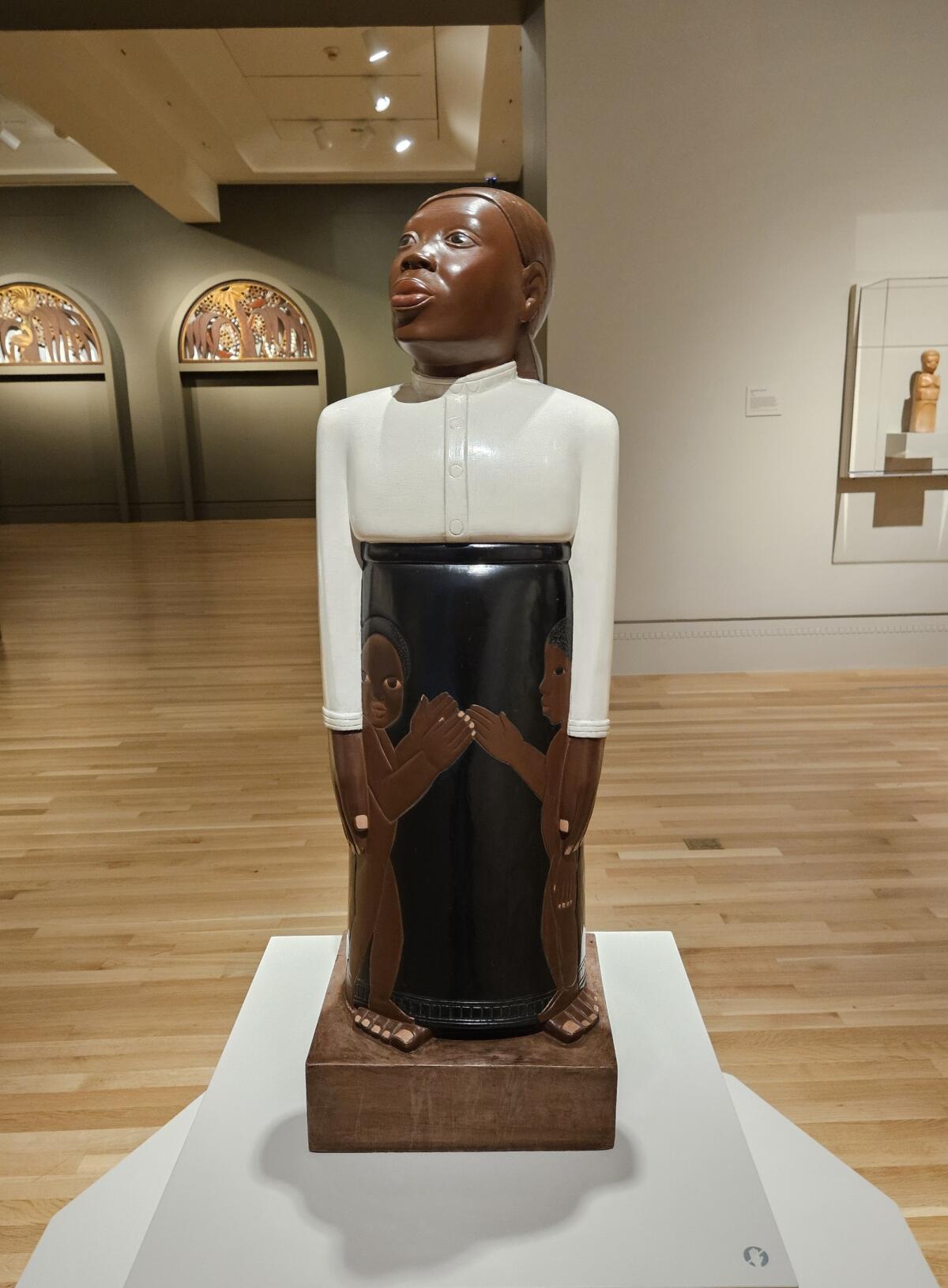
For Locke, art was a means of individual expression that could uncover and attract universal interest, connecting people across socially and culturally constructed concepts of race. It’s easy to see why Johnson’s work would appeal to this pluralist vision. Locke, as a homosexual, and Johnson, as an orphan adrift, grew up without the usual empathetic scaffolding of familial sustenance. A core commitment to self-love was a foundation for collective Black pride.
“Chester” was a critical success, winning exhibition awards in California and New York. So was “Forever Free,” which took a 1935 prize at the San Francisco Art Association and might now be Johnson’s most famous sculpture. Carved from wood as a durable, 3-foot-tall, totem-like column, it was then wrapped in linen, covered with smooth plaster and incised and painted. The sculpture shows a mom sheltering two kids.
Drawing is the core of Judithe Hernández’s 50-year survey at Riverside Art Museum’s Cheech Marin Center.
The color is painted in large, smooth blocks — brown head and hands, white blouse, black skirt, brown children. The cleverest element is found at the bottom. The woman’s skirt touches the floor, creating firm visual stability, but at the lower front edge, it just slightly lifts, and her feet protrude. There, the child incised into the skirt on the right turns out to be standing on one of their mom’s feet, while the child incised on the left is actively stepping up on her other foot.
Stylistically, those two small children, their flatly painted bodies incised in two-dimensional profile, slide back thousands of years to the African continent and Egyptian art — product of an ancient slave culture. “Forever Free” constructs an image of inseparable bonding and generational growth. Born of history, the woman lifts her head and looks to the side, as if pondering the future.
Johnson made many portraits of children, and they variously drew on traditional stylistic and technical sources in Chinese and Mexican art, as well as African sculpture. A stunning group of hammered copper masks also fuse Chokwe, Yombe and other sub-Saharan forms with sleek, Art Deco stylization.
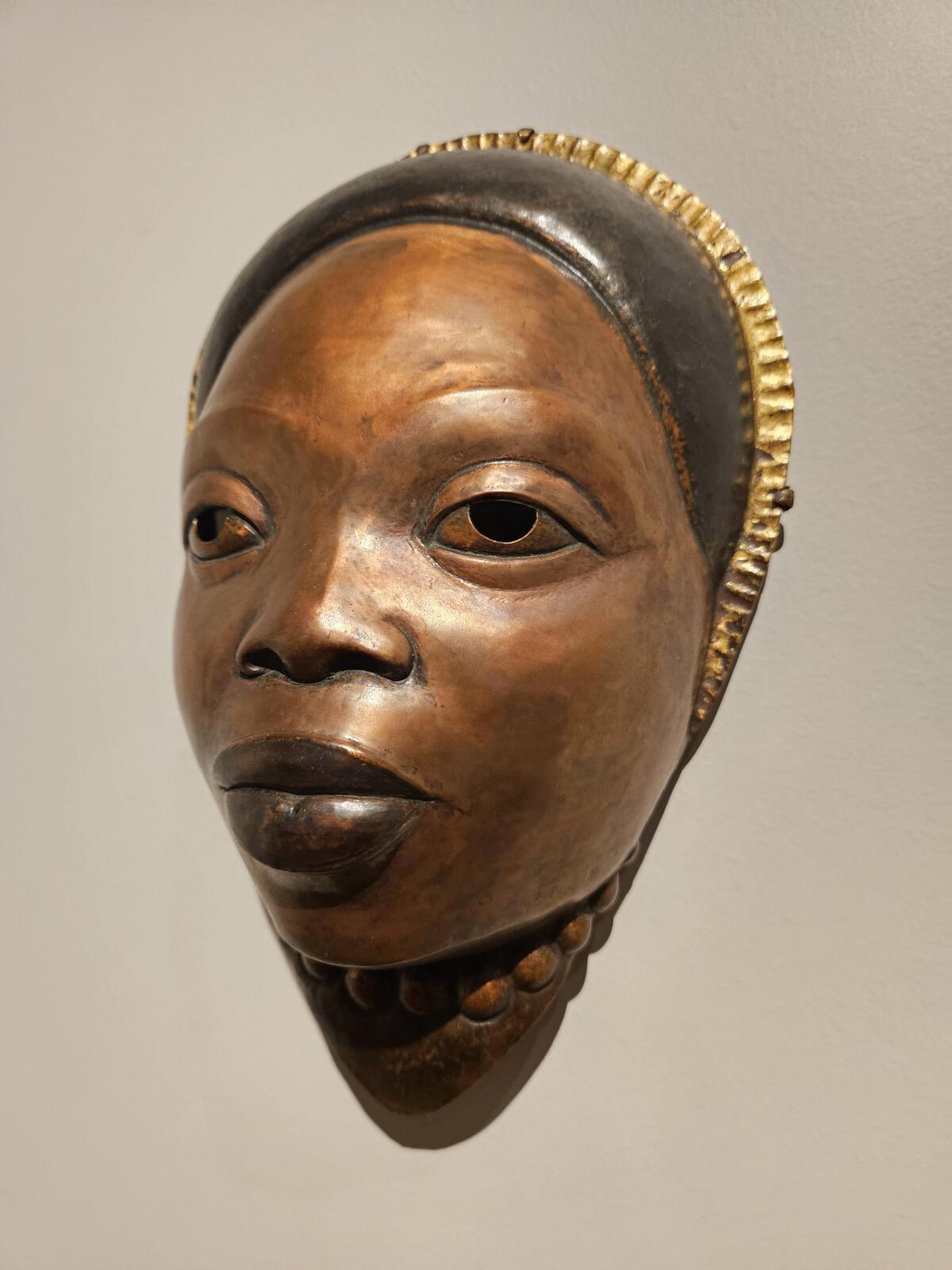
The first wave of the Great Migration that saw millions of Black Americans leave the rural South for the increasingly urban North and West was instrumental in creating the Harlem Renaissance. Given the name, we usually think of it as a New York phenomenon, but Johnson lived and worked in the Bay Area throughout his creative life. (He arrived in 1915 and died nearly penniless in 1967.) An exhibition currently at New York’s Metropolitan Museum of Art, which I have not seen, presents “The Harlem Renaissance and Transatlantic Modernism”; but Johnson drew on Pacific sources in Asia and Mesoamerica as well, perhaps because he worked on the West Coast.
The exhibition was organized by Huntington curator Dennis Carr with art historians Jacqueline Francis of the California College of the Arts and John P. Bowles of the University of North Carolina, Chapel Hill. The engine for the show was an extensive Works Progress Administration commission begun in 1933, which featured magnificent carved redwood reliefs for the auditorium of Berkeley’s California School for the Blind. One centerpiece, the decorative multi-part organ screen that is in the Huntington’s collection, has been reunited with other components for the first time in more than four decades.
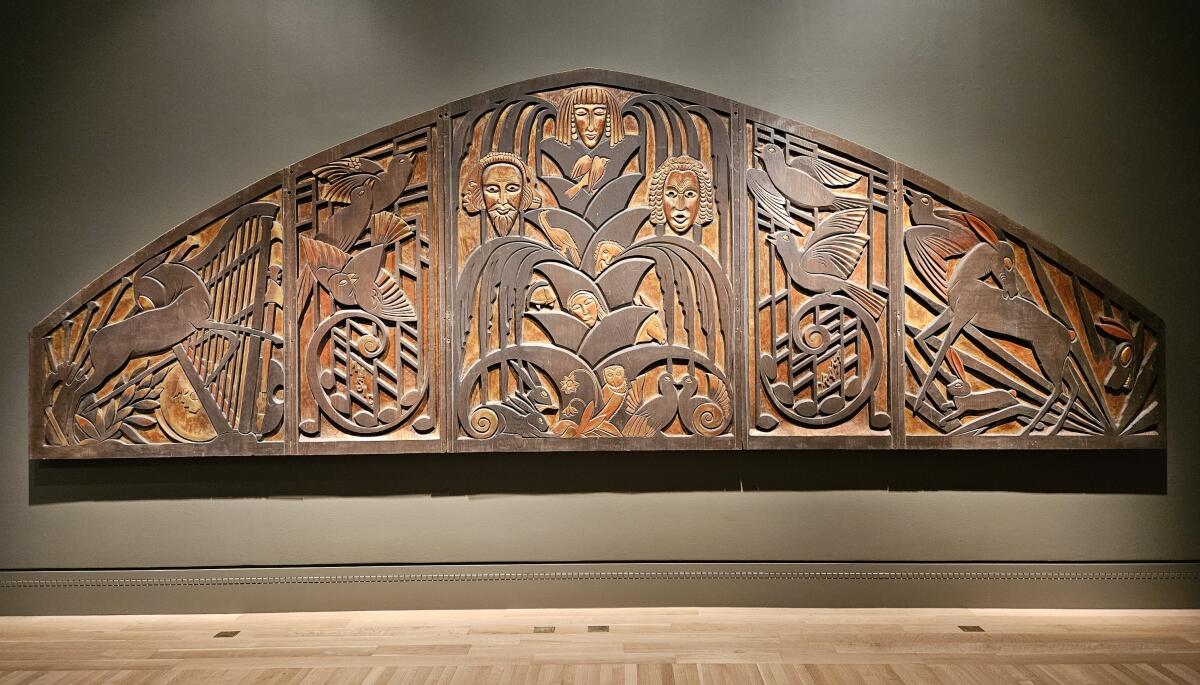
Both the organ screen and a large, 22-foot proscenium relief installed opposite are centered on stylized images of a tree of life — a globally resonant archetype prominent in countless cultures and eras, which the artist highlighted with bits of gilding. Birds sing, animals congregate.
One inspiration for the reliefs’ Art Deco style, as Carr notes in the exhibition catalog, may have been the graphic designs that German American artist Winold Reiss employed for Locke’s anthology, “The New Negro.” Like Mexican artists Miguel Covarrubias and Alfredo Ramos Martínez, Johnson also created dynamic, abstract pictorial rhythms by composing plant life in geometric, mirror-image shapes, rather than as an organic cornucopia. Nature is rendered unnaturally, one might say, sometimes intertwined with musical instruments, staffs and notes.
Johnson experimented with painting in enamel on metal at the end of his life, in the 1950s and ’60s, and some examples are included here. But they’re his weakest works. In the 1930s, he was at his peak. Think of the carved reliefs’ brilliant decor as visual jazz or swing, smartly orchestrated for a school for blind students where sound was a priority in the curriculum. Government art commissions just don’t get much better.
'Sargent Claude Johnson'
Where: Huntington Library, Art Museum and Botanical Gardens, 1151 Oxford Rd., San Marino
When: 10 a.m.–5 p.m. Closed Tuesdays. Through May 20.
Info: (626) 405-2100, www.huntington.org
More to Read
The biggest entertainment stories
Get our big stories about Hollywood, film, television, music, arts, culture and more right in your inbox as soon as they publish.
You may occasionally receive promotional content from the Los Angeles Times.
